Tired of buying wax-coated, dented, flavorless and mealy apples from the store? Did you know that most store-bought apples have lost many nutrients and contain forty percent fewer minerals than fruit grown and eaten fresh from a local orchard or your own backyard?
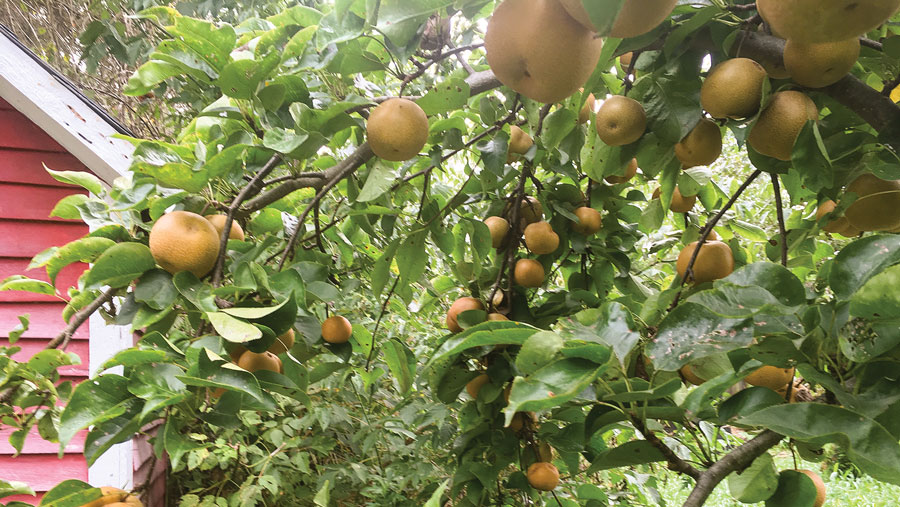
If you don’t believe it, ask orchardist Peter Tischler who offers a simple DIY test: “The easiest test I know is to take a bite of one (store-bought) and an organic apple off a tree. It’s amazing how much better that fruit can taste than an apple from a store. The typical apple from a store has been in storage for a year. The nutrition isn’t there. You can tell that by the taste.”
Tischler has managed two orchards in Asbury: a certified organic ten acre mixed tree fruit and berry orchard on forty acre ComeBack Farm, and the organically grown, though not certified, NewArk Farm, a forty acre hard cider orchard with seven thousand apple trees. But he believes “even one tree makes an orchard” and that anyone with a desire to grow their own fruit can succeed and have access to everything necessary.
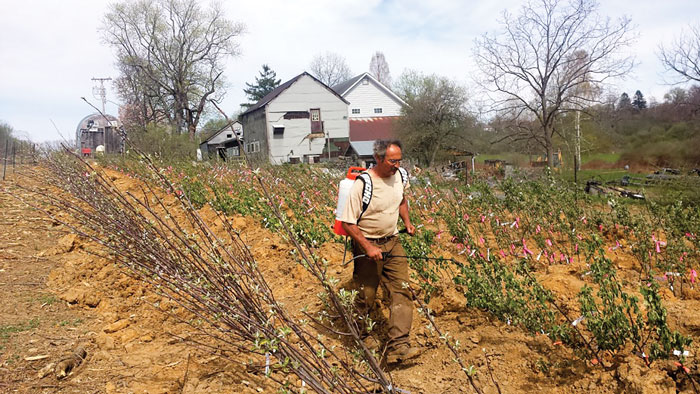
Backyard orchardist Gina Barkovitch owns and operates the six-acre Old Orchard Farm in Blairstown. She planted the trees herself, starting six years ago and adding more every year since. Though she has over one hundred fruit trees, she is not looking for commercial production; she is looking for diversity. Some are for canning, some to eat fresh or for cider, some are for history, and others are special aromatic apples such as Caville Blanc, a French variety from the 1600s, nutty and fruity with hints of vanilla and nutmeg. (Do you think you can get that from a store?) She grows historic apples, Asian pear, European peach and plum, Japanese plum, sweet and sour cherries, nectarines, peaches, apricots, pluot and aprium, quince and hazelnut. And she grows them all to organic standards, including her one hundred-plus berry bush patch with elderberry, twelve varieties of blueberry, six kinds of raspberries, jostleberry, gooseberry and cranberry, and white, yellow and red varieties of hybrid and French wood strawberry.
Steven Satch, self-proclaimed farmer in Frankford Township, believes in edible landscaping as evidenced by the many peach and nectarine trees in his front and backyards. “I started farming at five years old. At nine, I grew and sold forty-eight pumpkins door to door in a little red wagon and made five dollars. I started growing fruit trees at ten in Parsippany. I moved here and started growing twenty five peach trees in 2001 with four-foot high whips,” he says, and adds more every year including the recent planting of several varieties of hazelnuts he decided to try after the birds and brown rot ate up his cherries. On hazelnuts he says, “I want to cross breed the very best and produce more. We’re hoping this is going to be the first successful trial in Northern New Jersey and possibly the Northeast.”
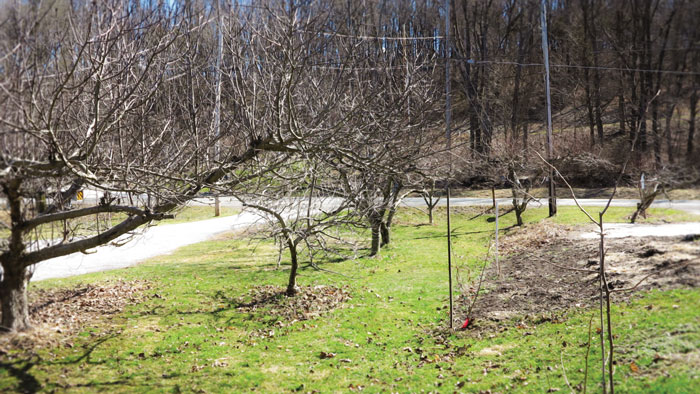
So how to do the backyard orchard without tons of pesticides? Easy. “Building the soil is the first line of defense,” Peter says of managing disease-prone apples. In an orchard you have the ability to work on the soil, building it from the top down. Apple trees like to be in a fungal, mycorrhizal environment and to make it so, mulch the trees with bark. (Mycorrhizae are fungi that live on tree roots. They extend the root system, thereby making minerals and water more available to the tree.) Gina’s dwarf and semi-dwarf fruit trees also grow on land that mimics their rightful habitat in nature the fungal forest edge. Don’t grow fruit trees on grass, a more bacterial habitat, says Gina, who surrounds her trees with bark chips that break down into fungal food. It’s not fair, she says, to expect a cherry tree or other fruit to grow in grass
Before planting, Peter advises: “Know your tree’s ultimate height and make sure it gets all the sunlight it needs.” Space fifteen to eighteen foot tall semi-standard trees at fifteen feet apart. Plant ten-foot tall dwarf trees six feet apart. Gina plants according to a biodynamic calendar on its Northern transplanting weeks and fruit days. “The earth is breathing with energy. She dowses for electric and gas lines, for mineral and nutritional quality, and for when to prune—apples and pears in winter; the others in summer. She dowses for the right spot to dig a hole to plant a tree. “I ask the trees where they want to be planted,” she says. “The bottom line is the health of the trees, the bees and the chickens in the orchard. It’s about the whole system. The trees have an intelligence that they can make better decisions for themselves than we can.” She holds a young tree in one hand and a dowsing rod in the other until her dowsing rod spins. Generally, she plants trees twelve to fifteen feet apart, depending on the rootstock.
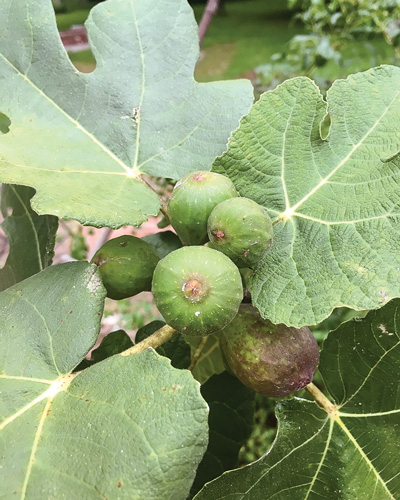
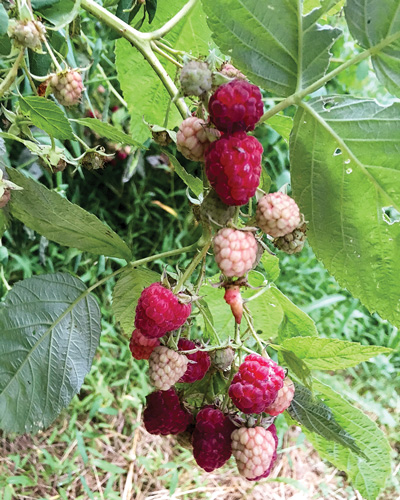
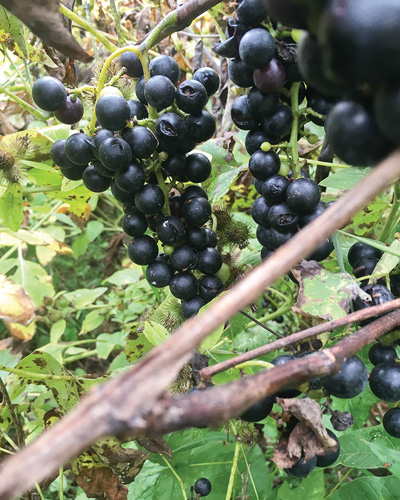
Know your soil type and plant accordingly. If you graft, make sure that the rootstock and scion are compatible. The scion dictates the fruit’s color, size and taste. The root determines the tree’s height, and soil and zone it can grow in. Know if your plant needs cross-pollination. Some trees need two types of pollen to form a fruit. Apples and pears need at least two different trees; peaches and apricots self-pollinate so one tree is sufficient if that’s all the room you have. “Even one tree is an orchard,” Peter says. Some sweet cherries need partners and some are self-fertile. A grafted “cocktail tree” has different fruits on its branches such as peaches, nectarines and apples.
Minerals, fencing and biology are used to prevent insects and disease. Protect tree trunks in winter from critters looking for food. Deer and rabbits can kill a tree by girdling, so fence your trees or layer pallets around the trunk. “The tips of fruit trees are so important,” says Gina. They contain minerals and enzymes, like a power pill, needed to produce fruit, but they are also desirable to deer. Branch tips are the tree’s fingers, taking in information, she says. Peter uses aromatic herbs and other plants in the orchard understory to attract beneficial insects and also those, such as comfrey, that benefit the trees directly by helping to build soil nutrients. He uses companion plants to repel insects and to lure carnivorous predators that eat bad herbivorous bugs. Other plants, such as borage, sweet cicely, lovage and clover, attract pollinators. The key to a healthy ecology is a diverse understory. Having something in bloom all season ensures that diversity.
To deter birds from eating your just-ripe cherries, hang shiny objects in the trees, says Gina. Birds are trained to think of red as fruit, so use white, silver or gold gadgets such as shiny DVDs or aluminum foil, she says. Self-pollinating trees are less susceptible to bird orgies. Disease-resistant, low maintenance sour “bush cherries” ripen earlier than tree cherries and outsmart unsuspecting birds. They’re not for eating but are good for cooking and winemaking, though the variety ‘Mont Morency’ is just sweet enough to eat. For the beginner, Gina recommends Asian pears—like juicy ‘Korean Giant’ that runs down your chin and your arm—and sour cherries.
Keep your central leader and cut out water sprouts. If a water sprout gets big and heavy enough, it will lean over, signaling the branch to produce a lot of fruit, an unhealthy demand on the tree. If a branch has many fruitlets, thin them out before they are the size of a quarter, leaving just one or two. Thinning fruitlets is the most important action for the quality of next year’s production and disease suppression. “Too much fruit compromises the tree. Fruit requires a lot of photosynthesis and minerals in the soil. Less is more. Thin and ask the tree to give you less fruit that’s better quality,” says Gina. Steven prunes his peaches spread wide open for maximum sunshine and says that’s why people love his sun-kissed fruit. His wife, Oksana, cans the bounty from their 350 tomato plants, peach trees and strawberries. They also harvest beets from the ground all winter.
Peter uses mineral foliar sprays to provide good plant nutrition, for a healthy plant is less susceptible to disease and insect attacks. Mineral uptake through foliar feeding is ten times better than from soil. Foliar sprays vary depending on timing. Knowing bud stages and the life cycles of insects and diseases, such as apple scab on buds and fire blight on open flowers, dictates what and when to spray. To be sure, he performs soil tests and leaf sap analyses to spot problems early and sprays when temperatures are between 80-85° and the leaves’ stomata are open.
Foliar sprays generally consist of liquid fish for nitrogen, a fatty acid for feeding fungal soil, kelp for trace minerals and growth hormones, trace and macro minerals, a biological component akin to a probiotic to outcompete bad bacteria in colonizing leaf surfaces and a little molasses to feed them, and humates to make minerals more available. Minerals might be calcium to fill fruit cells and potassium to sweeten the fruit. “There is absolutely no reason why a backyard orchardist can’t use these products.”